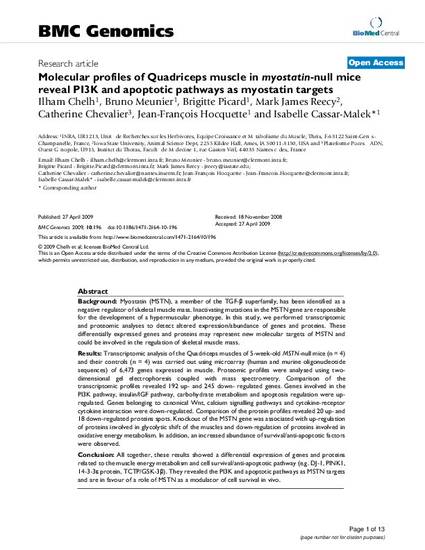
Myostatin (MSTN), a member of the TGF-β superfamily, has been identified as a negative regulator of skeletal muscle mass. Inactivating mutations in the MSTN gene are responsible for the development of a hypermuscular phenotype. In this study, we performed transcriptomic and proteomic analyses to detect altered expression/abundance of genes and proteins. These differentially expressed genes and proteins may represent new molecular targets of MSTN and could be involved in the regulation of skeletal muscle mass. Transcriptomic analysis of the Quadriceps muscles of 5-week-old MSTN-null mice (n = 4) and their controls (n = 4) was carried out using microarray (human and murine oligonucleotide sequences) of 6,473 genes expressed in muscle. Proteomic profiles were analysed using twodimensional gel electrophoresis coupled with mass spectrometry. Comparison of the transcriptomic profiles revealed 192 up- and 245 down- regulated genes. Genes involved in the PI3K pathway, insulin/IGF pathway, carbohydrate metabolism and apoptosis regulation were upregulated. Genes belonging to canonical Wnt, calcium signalling pathways and cytokine-receptor cytokine interaction were down-regulated. Comparison of the protein profiles revealed 20 up- and 18 down-regulated proteins spots. Knockout of the MSTN gene was associated with up-regulation of proteins involved in glycolytic shift of the muscles and down-regulation of proteins involved in oxidative energy metabolism. In addition, an increased abundance of survival/anti-apoptotic factors were observed. All together, these results showed a differential expression of genes and proteins related to the muscle energy metabolism and cell survival/anti-apoptotic pathway (e.g. DJ-1, PINK1, 14-3-3ε protein, TCTP/GSK-3β). They revealed the PI3K and apoptotic pathways as MSTN targets and are in favour of a role of MSTN as a modulator of cell survival in vivo.
Available at: http://works.bepress.com/james_reecy/62/

This article is from BMC Genomics 10 (2009): 196, doi:10.1186/1471-2164-10-196. Posted with permission.